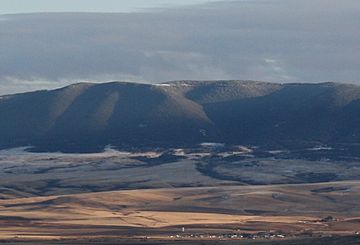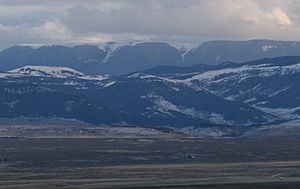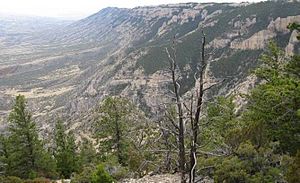Pryor Mountains facts for kids
Quick facts for kids Pryor Mountains |
|
|---|---|

Pryor Mountains
|
|
| Highest point | |
| Peak | East Pryor Mountain |
| Elevation | 8,776 ft (2,675 m) |
| Naming | |
| Native name | Error {{native name}}: an IETF language tag as parameter {{{1}}} is required (help) |
| Geography | |
| Country | United States |
| State | Montana |
The Pryor Mountains are a mountain range found in Montana. They are located in Carbon and Big Horn counties. You can find them south of Billings, Montana, and north of Lovell, Wyoming.
These mountains are part of the Crow Indian Reservation and the Custer National Forest. Some parts are also on private land.
The mountains got their name from Sergeant Nathaniel Hale Pryor. He was a member of the famous Lewis and Clark Expedition. He tried to get back horses that were stolen from the expedition in this area.
The Crow Nation, a Native American tribe, lived nearby. They called these mountains Baahpuuo Isawaxaawuua. This means "Hitting Rock Mountains." They used this name because there was a lot of flint here. Flint was used to make sharp arrowheads.
According to old stories from the Crow Nation, special "Little People" lived in these mountains. These were dwarf-like people, about 18-inch (46 cm) tall. They were believed to have spiritual powers.
Contents
Exploring Pryor Mountain Geology
The Pryor Mountains cover a large area in Montana and Wyoming. They are made up of different types of rocks. Most of these rocks are sedimentary rocks. The most common type is limestone, called Madison Group limestone. This limestone formed about 300 million years ago.
Below the limestone are even older rocks. These are metamorphic rocks like gneiss and schist. You can see the gneiss on the northeast side of East Pryor Mountain. About 70 to 60 million years ago, during a time called the Laramide orogeny, the limestone was pushed up. This created the large blocks of mountains we see today.
Caves and Unique Features
The limestone in the Pryors has many caves. These caves were carved out by groundwater over time. Some well-known caves include Big Ice Cave and Mystery Cave. Mystery Cave has some of the most beautiful speleothems, which are cave formations.
Other interesting caves are False Cougar Cave, used by Native Americans long ago. Shield Trap Cave has a deep vertical shaft, about 33 feet (10 m) deep. Little Ice Cave and Bell Trap Cave are also notable.
Besides caves, the Pryors have other cool spots. Froggs Fault is a huge crack in the earth. There's also a buffalo jump near Dry Head Lookout. A buffalo jump was a place where Native Americans hunted bison by driving them off a cliff.
Near Dry Head Lookout, there is a small, special place. It's a pocket in the cliff with a low rock fence. Several Native American tribes used this spot for vision quests. It was a very important spiritual place.

The highest point in the Pryor Mountains is East Pryor Mountain. It reaches an elevation of 8,822 feet (2,689 m).
The Bighorn River flows north from Wyoming. It passes between the Bighorn and Pryor mountains. The river has carved out the impressive Bighorn Canyon into the limestone.
Pryor Mountain Wildlife
Crooked Creek is one of the few streams in the area that flows all year. It divides the Pryor Mountains into two parts. This creek is one of the rare places where you can find Yellowstone cutthroat trout.
The Pryor Mountains are also home to many different kinds of bats. In fact, they have the most diverse bat habitat in all of Montana. Ten different species of bats live here.
Pryor Mountains Wild Horse Range
The Pryor Mountains are famous for being home to the Pryor Mountains Wild Horse Range. This is a special protected area. It is where a herd of free-roaming feral horses lives. These horses are wild and live freely in the mountains.
This herd of wild horses became very well known. They were featured in two documentary films. The first was Cloud: Wild Stallion of the Rockies in 1995. The second was its sequel, Cloud's Legacy: The Wild Stallion Returns, released in 2003. These films helped people learn about and appreciate these amazing wild horses.



